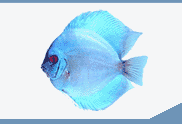

 |
||||||||||||
 |
||||||||||||
| Introduction to Freshwater Fish Parasites | ||||||
| Page 7 of 14 | Pages: 1 . 2 . 3 . 4 . 5 . 6 . 7 . 8 . 9 . 10 . 11 . 12 . 13 . 14 | |||||
Piscinoodinium Piscinoodinium is a sedentary flagellate that attaches to the skin, fin, and gills of fish. The common name for Piscinoodinium infection is "Gold Dust" or "Velvet" Disease. The parasite has an amber pigment, visible on heavily infected fish. Affected fish will flash, go off feed, and die. Piscinoodinium is most pathogenic to young fish. The life cycle of this parasite can be completed in 10--14 days at 73--77�F ( Figure12 ), but lower temperatures can slow the life cycle. Also, the cyst stage is highly resistant to chemical treatment. Therefore, several applications of a treatment ( Table 1 ) may be necessary to eliminate the parasite.  Figure 12: Life cycle of a Piscinoodinium sedentary flagellate.
Figure 12: Life cycle of a Piscinoodinium sedentary flagellate.
For non-food species, chloroquin (10mg/L prolonged bath) has been reported to be efficacious. For more information, see IFAS Fact Sheet VM-90 , Amyloodinium Infections of Marine Fish , the marine counterpart to Piscinoodinium . Cryptobia Cryptobia is a flagellated protozoan common in cichlids. They are often mistaken for Hexamita as they are similar in appearance. However, Cryptobia are more drop-shaped, with two flagella, one on each end. Also, Cryptobia "wiggles" in a dart-like manner, whereas Hexamita "spirals".  Figure 13: A staining of a Cryptobia flagellated protozoan.
Figure 13: A staining of a Cryptobia flagellated protozoan.
Cryptobia typically is associated with granulomas ( Figure 13 ), in which the fish "walls off" the parasite. These parasites have been observed primarily in the stomach, but may be present in other organs. Fish afflicted with Cryptobia may become thin, lethargic and develop a dark skin pigmentation. A variety of treatments are presently being studied with limited success. Nutritional management has proven to take an active role in its control. Myxozoa Myxozoa are parasites that are widely dispersed in native and pond-reared fish populations. Most infections in fish create minimal problems, but heavy infestations can become serious, especially in young fish. Myxozoans are parasites affecting a wide range of tissues. They are an extremely abundant and diverse group of organisms, speciated by spore shape and size. Spores can be observed in squash preparations of the affected area at 200 or 400x magnification or by histologic sections. Clinical signs vary, depending on the target organ. For example, fish may have excess mucus production, observed with Henneguya ( Figure 14 ) infections.  Figure 14: An illustration of a Myxozoa parasite.
Figure 14: An illustration of a Myxozoa parasite.
White or yellowish nodules may appear on target organs. Chronic wasting disease is common among intestinal myxozoans such as with Chloromyxum. "Whirling disease" caused by Myxobolus cerebralis has been a serious problem in salmonid culture. Elimination of the affected fish and disinfection of the environment is the best control of myxozoans. There are no established remedies for fish. Spores can survive over a year, so disinfection is mandatory for eradication. See IFAS Fact Sheet VM-87 , Sanitation Practices for Aquaculture Facilities . more ... |
 |
|||||
| About Us :: Message Board :: Chat | |||||
| Library :: Photo Gallery :: Links & Resources :: Breeders & Sponsors :: Merchandise | |||||
| Website designed by: EthanCote.com | � 2001-2004, SimplyDiscus.com. All Rights Reserved. | ||||